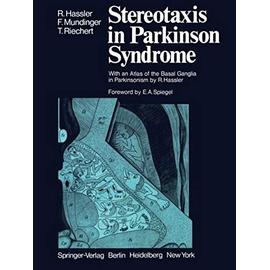
Stereotaxis in Parkinson Syndrome: Clinical-Anatomical Contributions to Its Pathophysiology - edizione con copertina flessibile
2012, ISBN: 9783642665233
Foreword: Spiegel, E.A. Springer, Paperback, Auflage: Softcover reprint of the original 1st ed. 1979, 332 Seiten, Publiziert: 2012-06-29T00:00:01Z, Produktgruppe: Book, Hersteller-Nr.: bi… Altro …
| amazon.co.uk Costi di spedizione:Die angegebenen Versandkosten können von den tatsächlichen Kosten abweichen. (EUR 5.60) Details... |

Stereotaxis in Parkinson Syndrome Clinical-Anatomical Contributions to Its Pathophysiology - edizione con copertina flessibile
2012, ISBN: 3642665233
Softcover reprint of the original 1st ed. 1979 Kartoniert / Broschiert Pathologie, Neurologie und klinische Neurophysiologie, mus; StereotaktischeHirnchirurgie; biochemistry; differenti… Altro …
| Achtung-Buecher.de MARZIES.de Buch- und Medienhandel, 14621 Schönwalde-Glien Costi di spedizione:Versandkostenfrei innerhalb der BRD. (EUR 0.00) Details... |

2012, ISBN: 9783642665233
edizione con copertina flessibile
Clinical-Anatomical Contributions to Its Pathophysiology, Buch, Softcover, Softcover reprint of the original 1st ed. 1979, [PU: Springer Berlin], Springer Berlin, 2012
| lehmanns.de Costi di spedizione:Versand in 10-14 Tagen. (EUR 0.00) Details... |

ISBN: 9783642665233
Springer , pp. xii + 315 1st Edition, Reprint . Papeback. New., Springer, 6
| Biblio.co.uk |

ISBN: 9783642665233
Livre, [PU: Springer, Berlin/Heidelberg/New York, NY]
| Rakuten.fr |


Stereotaxis in Parkinson Syndrome: Clinical-Anatomical Contributions to Its Pathophysiology - edizione con copertina flessibile
2012, ISBN: 9783642665233
Foreword: Spiegel, E.A. Springer, Paperback, Auflage: Softcover reprint of the original 1st ed. 1979, 332 Seiten, Publiziert: 2012-06-29T00:00:01Z, Produktgruppe: Book, Hersteller-Nr.: bi… Altro …
Hassler, R.; Riechert, T.; Mundinger, F.:
Stereotaxis in Parkinson Syndrome Clinical-Anatomical Contributions to Its Pathophysiology - edizione con copertina flessibile2012, ISBN: 3642665233
Softcover reprint of the original 1st ed. 1979 Kartoniert / Broschiert Pathologie, Neurologie und klinische Neurophysiologie, mus; StereotaktischeHirnchirurgie; biochemistry; differenti… Altro …

2012
ISBN: 9783642665233
edizione con copertina flessibile
Clinical-Anatomical Contributions to Its Pathophysiology, Buch, Softcover, Softcover reprint of the original 1st ed. 1979, [PU: Springer Berlin], Springer Berlin, 2012
ISBN: 9783642665233
Springer , pp. xii + 315 1st Edition, Reprint . Papeback. New., Springer, 6
Dati bibliografici del miglior libro corrispondente
| Autore: | |
| Titolo: | |
| ISBN: |
Informazioni dettagliate del libro - Stereotaxis in Parkinson Syndrome
EAN (ISBN-13): 9783642665233
ISBN (ISBN-10): 3642665233
Copertina flessibile
Anno di pubblicazione: 2012
Editore: Springer Berlin
Libro nella banca dati dal 2012-07-25T16:13:55+02:00 (Zurich)
Pagina di dettaglio ultima modifica in 2023-10-26T14:19:18+02:00 (Zurich)
ISBN/EAN: 9783642665233
ISBN - Stili di scrittura alternativi:
3-642-66523-3, 978-3-642-66523-3
Stili di scrittura alternativi e concetti di ricerca simili:
Autore del libro : riechert, hässler, spiegel, hass, glauner, mundi, hassler
Titolo del libro: parkinson syndrome, stereo, clinical, syndrom, park, stere, pathophysiology
Dati dell'editore
Autore: R. Hassler; F. Mundinger; T. Riechert
Titolo: Stereotaxis in Parkinson Syndrome - Clinical-Anatomical Contributions to Its Pathophysiology
Editore: Springer; Springer Berlin
320 Pagine
Anno di pubblicazione: 2012-06-29
Berlin; Heidelberg; DE
Stampato / Fatto in
Peso: 0,824 kg
Lingua: Inglese
53,49 € (DE)
54,99 € (AT)
59,00 CHF (CH)
POD
XII, 320 p.
BC; Neurology; Hardcover, Softcover / Medizin/Klinische Fächer; Neurologie und klinische Neurophysiologie; Verstehen; Parkinsonismus; Stereotaktische Hirnchirurgie; biochemistry; differential diagnosis; dysarthria; electroencephalography (EEG); neuropathology; Parkinson; pathology; pathophysiology; physiology; tremor; Neurosciences; Pathology; Neurology; Neuroscience; Pathology; Neurowissenschaften; Pathologie; BB
I. Introduction.- II. Basis of the Parkinson Syndrome: Morphology, Physiology, Biochemistry, and Pathology.- 1. Afferent Inputs of the Extrapyramidal Motor Nuclei.- 1.1. Putamen and Cauda tum ( = Striatum).- 1.2. Pallidum.- 1.3. Nucleus Subthalamicus.- 1.4. Nucleus Ruber.- 1.5. Substantia Nigra.- 2. Connections Within the Extrapyramidal System and the Functional Significance of Individual Nuclei.- 2.1. Putamen and Cauda tum ( = Striatum).- 2.2. Pallidum.- 2.3. Nucleus Ruber.- 2.4. Substantia Nigra.- 2.4.1. Synapses of the Striato-Nigral Circuit and Their Transmitters.- 2.4.2. Mode of Action of the Anticholinergic Drugs Against Parkinson Symptoms.- 2.4.3. Efferent Pathways of the Substantia Nigra.- 2.4.4. Neuropathology of the Substantia Nigra.- 2.4.5. Anatomical Differential Diagnosis of the Parkinson Syndrome.- 2.4.6. Localization of the Various Signs in Parkinsonism.- 2.4.7. Experimental Lesions in Substantia Nigra.- 2.4.8. Stimulation of the Substantia Nigra.- 2.5. Other Neuronal Systems Linked to the Extrapyramidal System.- 2.5.1. Nucleus Lateropolaris (L.po or VA).- 2.5.2. Nucleus Ventro-oralis anterior (V.o.a) or Anterior Part of the Ventral Half of the Nucleus Ventralis Lateralis (VL).- 2.5.3. Nucleus Ventro-oralis posterior (V.o.p) or Caudal Part of the Ventral Half of VL.- 2.5.4. Nucleus Ventrointermedius (V.im.- 2.5.5. Nucleus Ventrocaudalis (V.c.e= VPL and V.c.i= VPM).- III. Clinical and Pathophysiologic Findings Related to Autopsy Data in Cases of Parkinsonism Operated on by Stereotaxis.- 1. Methods.- 2. Case Histories.- IV. Correlations.- 1. Remarks on the Accuracy of Reaching the Target.- 2. Comparative, Radiologic, and Anatomical Evaluation of the Cerebral Reference Lines.- 2.1. Sagittal Reference Line or Baseline.- 2.2. Vertical Reference Line.- 2.3. Reference Line in the Frontal Plane.- 3. Anatomical Accuracy of Our Stereotaxic Procedure for Reaching the Target.- 3.1. Discussion of Accuracy.- 4. Correlation of the Effects of Stimulation During the Operation with the Anatomical Substrates.- 4.1. Method of Stimulation.- 4.2. Increasing the Tremor.- 4.3. Blocking of Tremor.- 4.4. Slowing of Rhythm of Tremor.- 4.5. Acceleration of Tremor.- 4.6. Jerks at Rate of Stimulation.- 4.7. Change in Speed of Movement.- 4.8. Change in Counting.- 4.9. Ocular Effects.- 4.10. Vegetative Effects.- 4.11. Psychological Effect of Stimulation.- 5. Correlation of the Electrophysiologic Findings with the Anatomical Substrates.- 6. Correlation of Coagulations of the Anatomical Structures with Functional and Therapeutic Effectiveness.- 6.1. Physical Parameters and Size of Coagulated Area.- 6.1.1. Methods ofInactivation.- 6.1.2. Used Methods of High-Frequency Coagulation.- 6.1.3. Anatomical Determination of the Size of Coagulation and the Consequent Alterations.- 6.2. Correlation of Parkinson Symptoms with the Coagulated Structures.- 6.3. Correlation of Rigidity.- 6.3.1. Thalamotomy.- 6.3.2. Significance of the Pallidothalamic Systems for the Production of Rigidity.- 6.4. Correlation of Tremor.- 6.4.1. Thalamotomy.- 6.4.2. Pallidotomy.- 6.4.3. Influence of Different Parts of the Internal Capsule on the Effect on the Tremor.- 6.4.4. Significance of the Dentato-thalamocortical System for Mechanism of Tremor.- 6.5. Correlation of Akinesia, Neglect, and Festination.- 6.5.1. Discussion of the Concept of Akinesia and Hypokinetic Signs.- 6.5.2. Correlations of Hypokinetic Signs.- 6.5.3. Relevance of Extrapyramidal Systems to Akinesia and Hypokinetic Signs.- 6.6. Correlation of the Vegetative Symptoms with Inactivated Structures.- 6.7. Correlation of Side Effects with the Damaged Structures.- 6.7.1. Reduction of Expressive Facial Movements.- 6.7.2. Voluntary Weakness of the Facial Nerve.- 6.7.3. Reduction of the Postural Tone of the Arm.- 6.7.4. Deviation During Walking.- 6.7.5. Hemiparesis.- 6.7.6. Dysphagia.- 6.7.7. Aphonia.- 6.7.8. Dysarthria.- 6.7.9. Postoperative Binocular Deviation.- 6.7.10. Ballistic Hyperkinesia.- 6.7.11. Myoclonic Hyperkinesia.- 6.8. Correlation of Postoperative Psychological Disorders with the Damaged Structures.- 6.8.1. Disorders ofInitiative.- 6.8.2. Experience of the Double (Doppelganger).- 6.8.3. Negativism with Mutism or Vigil Coma.- 6.8.4. Confusional Syndrome.- 6.8.5. Impairment of Consciousness.- V. Findings Regarding the Functional Anatomy of Individual Diencephalic Systems.- 1. Lesions in Forel’s Bundle HI (Fasciculus Pallido-thalamicus).- 2. Change of Speed of Movement and Laughing Caused by Localized Stimulation.- 3. Loquaciousness.- 4. Functional Organization of the Internal Capsule Corresponding to the Neighboring Ventral Nuclei of the Thalamus.- 5. Dependence of the Improvement of Tremor on Additional Coagulation of the Nucleus Lateropolaris and Neighboring Parts of the Internal Capsule.- 6. Contribution to the Problem of Efferent Connections of the Substantia Nigra.- 7. Impairment of Consciousness Due to Bilateral Lesions in Nonspecific Nuclei of the Thalamus or in the Pallidothalamic System.- VI. Conclusions.- 1. Determination of the Target Point in the Individual Patient.- 2. High-Frequency Coagulations.- 3. Check by Stimulation.- 4. Further Checks on the Accuracy with which the Target Structure is Reached.- 5. Special Indications for Therapeutic Results.- 5.1. Rigidity of Parkinsonism.- 5.2. Akinesia and Hypokinesia.- 5.3. Tremor at Rest.- 6. Pathophysiology of Parkinson Syndrome.- 6.1. Tentative Interpretations of Parkinson Symptoms: a) Disorders of Nigrostriatal Circuit Function and b) Antagonism of Descending Nigral and Pyramidal Impulses in Anterior Horn Apparatus.- 6.2. Tremor.- 6.3. Rigidity.- 6.4. Akinesia and Festination.- 6.5. Vegetative Symptoms.- 6.6. Bradyphrenia.- 6.7. Pathomorphologic Differential Diagnosis of the Different Etiologic Forms of Parkinsonism.- 6.8. Are the Described Cases Representative?.- 6.9. The Future of Therapy in Parkinsonism.- Atlas of the Basal Ganglia in Parkinsonism.- 1. Architectonic Differentiation and Methods of Staining.- 2. Arrangement of the Planes of Section.- 3. Introduction to the Determination of Individual Target Points.- 4. Description of the Series of Frontal Sections.- 5. Description of Serial Sagittal Sections.- References.Altri libri che potrebbero essere simili a questo:
Ultimo libro simile:
9783642665219 Stereotaxis in Parkinson Syndrome (R. Hassler/ F. Mundinger/ T. Riechert)
- 9783642665219 Stereotaxis in Parkinson Syndrome (R. Hassler/ F. Mundinger/ T. Riechert)
- 9783540080053 Stereotaxis in Parkinson Syndrome: Clinical-Anatomical Contributions to Its Pathophysiology (R. Hassler, F. Mundinger, T. Riechert, E.A. Spiegel)
- 9780387080055 Stereotaxis in Parkinson syndrome: Clinical-anatomical contributions to its pathophysiology (R. G Hassler)
< Per archiviare...


